If there is one National Hockey League team whose goaltending tandem for 1965-66 is etched in stone, it’s the Toronto Maple Leafs. At least that is the case after the NHL’s June meetings, but leading up to the league’s annual conclave, there was heavy speculation that Toronto would shed one of its two veteran goalkeepers.
Most every hockey fan knows the story of the close competition for the Vezina Trophy in the 1964-65 season. Detroit Red Wing goalie Roger Crozier led the race most of the way, but was closely followed by the Leaf duo of Johnny Bower and Terry Sawchuk, who split Toronto’s games almost evenly. Bower put up a spectacular performance in the last game of the season to move he and Sawchuk past Crozier and give Toronto the best goal-against average in the league.
The NHL amended its existing rule to allow both goaltenders’ names to be engraved on the trophy.
Imlach’s Draft Antics
After the season, and leading up to the draft, Toronto general manager Punch Imlach was faced with a dilemma to which there was no easy solution. The league allows teams to protect only two goalkeepers in the annual Intra-league draft. However, Toronto had a third goalkeeper, Rochester’s Gerry Cheevers, who was the best netminder in the American Hockey League. Cheevers had given every indication he is primed and ready for NHL competition, and Imlach did not want to lose him for just the $30,000 draft fee.
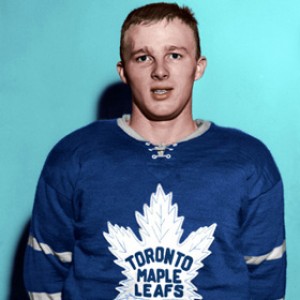
Imlach tried to trade Cheevers, but no team that needed goalkeeping would surrender what the wily Leaf GM felt was equal value. Speculation was rampant that the Leafs would protect the 24-year-old Cheevers and leave either Sawchuk or Bower exposed.
On draft day, Imlach tried to pull a fast one and listed Cheevers as a forward on his protected list. Even before any team could lodge a protest, NHL president Clarence Campbell stepped in, told Imlach that the move was not within the boundaries of the draft rules, and proclaimed Cheevers available for selection. The Boston Bruins, with first pick in the draft by virtue of their last-place finish in the 1964-65 NHL regular season, wasted no time in announcing that Cheevers would become a Bruin.
That left the Leafs with Bower and Sawchuk to once again share the Toronto goaltending job – not a terrible situation.
There are others in the Toronto organization who will get a look at training camp this fall and we’ll look at the list of incumbents and contenders now.
Terry Sawchuk
Last summer, Imlach pulled a bit of sleight-of-hand when he snatched goalie Terry Sawchuk from the Detroit Red Wings at the Intra-league draft. The surprising move proved to be brilliant, as “Ukey”, as he is known to his team mates, teamed with Johnny Bower to give the Leafs a Vezina Trophy-winning combination.
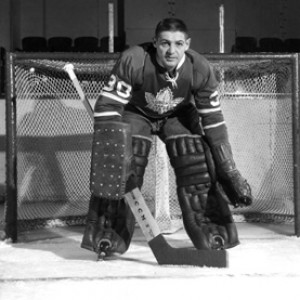
Sawchuk played in 36 games for the Leafs, posting a fine 2,56 goal-against average. He showed that at 35 years of age, an aging goaltender with the proper rest can not only stand up to the rigors of a 70-game NHL schedule, but that he can excel.
Sawchuk moved from his native Winnipeg to Ontario to play junior hockey with the Galt Red Wings of the OHA. In 1946-47 he compiled a 26-8-0 record and the parent Detroit Red Wings were so impressed they accelerated his development the following season. He began in Windsor of the OHA Junior A league, played a few games with the semi-pro International Hockey League Bulldogs before moving to the semi-pro United States Hockey League with the Omaha Knights. Sawchuk took that league by storm, leading in goals-against with a 3.21 average in 54 games. He was named the loop’s rookie of the year.
Sawchuk spent the next two seasons with the Indianapolis Capitals. His AHL time culminated in a first all-star team selection and a Calder Cup (AHL championship) victory. He had a 7-game trial with the Red Wings, showed very well and Wings’ GM Jack Adams knew he had a winner in goal for years to come.
In the 1950-51 season, Sawchuk played every game for the Red Wings and won the Calder Memorial Trophy as NHL rookie of the year. He averaged an amazing 1.99 goals against, just missing out on the Vezina trophy.
Sawchuk immediately became one of the games’ great goalkeepers. He won Stanley Cups in 1952, 1954 and 1955. All-star nominations were almost a rite of passage.
In June of 1955, after winning 40 of the 68 games he had played, and copping a Vezina Trophy with an average of 1.94, the Red Wings suddenly decided, rather inexplicably, to trade Sawchuk to the Boston Bruins. A young up-and-coming netminder by the name of Glenn Hall had caught Jack Adams’ eye and he felt he could bolster the Red Wings by dealing Sawchuk.
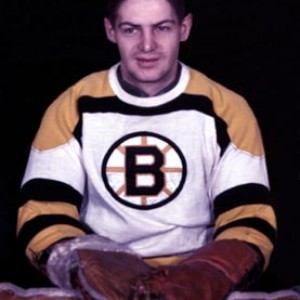
Sawchuk’s time in Boston was not a happy one, and he left the Bruins midway through his second season, due to illness. At the end of the 1956-57 season, Terry was sent back to Detroit in a straight up trade for a young left winger named Johnny Bucyk – a trade that truly worked out for both clubs.
Sawchuk continued his Detroit career, but he was never quite the superstar goalie he had been before the trade to Boston. That was likely due to the Detroit club was not nearly as strong as it had been in the early 50’s. When the Red Wings were convinced that young Roger Crozier was ready to assume the mantle of number one netminder, Sawchuk was exposed in the draft last summer, and the rest is history.
Johnny Bower
Never was Johnny Bower’s nickname “The China Wall” more appropriate than the last game of the 1964-65 season. Bower’s goaltending heroics in that final game enabled he and partner Terry Sawchuk to move past the Red Wings’ fine rookie goalie Roger Crozier and claim the Vezina Trophy. Bower simply refused to let anything get by in that last game.
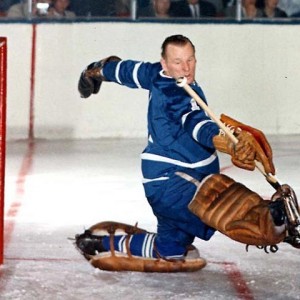
Not only was Bower as solid as the legendary Chinese wall, but some claim he is just as old.
Bower was born in Prince Albert, Saskatchewan, some time after 1920, at least that much seems certain. Bower himself doesn’t admit to a particular year, although he has dropped hints in the past that 1924 would be a good guess. That would still put him in his 40’s, although the game he plays is that of a much younger man. Toronto GM Punch Imlach absolutely loves the affable veteran, and it’s likely “Old Jawn” will have a home in Toronto as long as he wants.
Bower played minor hockey in his native Prince Albert before enlisting in the Canadian Army in 1941. He stayed in the military until 1944, upon which he returned to Prince Albert to play junior and intermediate hockey.
In 1945-46 he tried out for and made the Cleveland Barons of the American Hockey League, thus beginning one of the great AHL goaltending careers. He starred with Cleveland until the summer of 1953 when he was traded to the NHL’s New York Rangers with Eldred Kobussen for Emile Francis, Neil Strain and cash. Bower played every game as a rookie for the Rangers, recording a commendable 2.53 goals-against average. However, that wasn’t quite good enough for the Rangers’ brass and the very next season he found himself back in the minors with the Western Hockey League Vancouver Canucks.
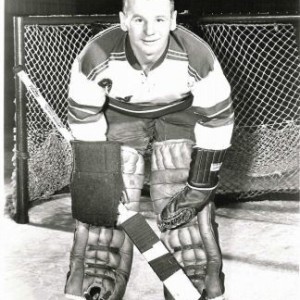
Bower had brief stints with the Rangers in 54-55 and 56-57 but was never able to nail down a regular job. In 1957 the Rangers finally traded his rights back to Cleveland. Once again in the AHL city in which he began, Bower had a stellar season, winning the Harry “Hap” Holmes Trophy as the AHL’s leading goaltender, as well as the Les Cunningham Trophy as AHL Most Valuable Player.
Punch Imlach, always on the lookout for talent and not afraid to give a veteran another chance, drafted Bower from Cleveland in the Inter-league draft in June of 1958. Bower, however, had resigned himself to the fact he wasn’t ever going to be a regular in the NHL and was happy in Cleveland. He told Imlach he wasn’t interested in a move to Toronto and preferred to stay in Cleveland. Imlach finally convinced Bower to give the Leafs a try.
In his first season with Toronto he split the job with Ed Chadwick, winning the position outright in 1959-60. He’s been a Leaf hero ever since, with three Stanley Cups to his credit.
Gary Smith
Ottawa native Gary Smith, 21, is hoping to see more action after a first professional season that saw him shuffled throughout the Toronto organization, playing only 10 games. He was even loaned to the Boston Bruins during an injury crisis for the NHL cellar-dwellers, but didn’t see action. The Bruins tried to trade for the six-foot, four-inch, 215 pounder but Punch Imlach would not give him up.
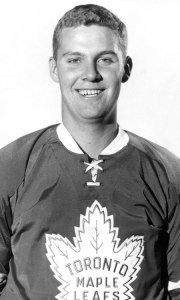
Smith came up through the Toronto junior system. He played for the St. Michael’s Majors and Neil McNeil Maroons in the short-lived Metro Junior A League in Toronto between 1962 and 1964 before winning a Memorial Cup with the Toronto Marlboros in 1964.
Smith is a big man and covers a lot of net. He is an aggressive goaltender, but prone to lapses in concentration and consistency. He is the son of former NHL forward Des Smith.
He’ll likely spend the season with Tulsa in the CPHL, although the job in Rochester is wide-open as well.
Bobby Perreault
Thirty-four-year-old Bobby Perreault, also known as Miche, has been around the professional hockey ranks since 1951. The Leafs picked up the five-feet, eight-inch, 170 pound veteran this summer by way of the Reverse Draft, where NHL teams can select players from minor league squads. Having lost Don Simmons to the New York Rangers in the NHL Intra-league draft, Punch Imlach decided he needed another veteran replacement, and grabbed Perreault, likely for the Victoria WHL farm club, from San Francisco of that same league.
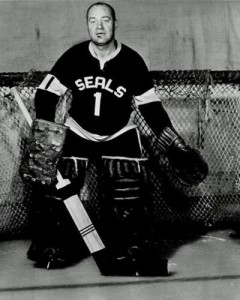
Perrault has bounced around, but has seen some NHL action over the years. He got into six games with the Montreal Canadiens as an injury replacement for Jacques Plante in the 1955-56 season. He was drafted by Detroit from Montreal in 1957 and played three games for the Wings in January of 1959, again as an injury fill-in, this time for Terry Sawchuk.
The Red Wings traded Perreault to Boston in the summer of 1962 for Ed Chadwick and Barry Ashbee. Perreault lasted only 22 unimpressive games with a bad Boston team before being replaced by Ed Johnston. For the past two seasons, he’s been with San Francisco.
Other goalies in the system:
- Al Smith, 20, a highly regarded youngster with the Toronto Marlboros.
- Al Millar, 35, another minor-league veteran who had a cup of coffee with the Bruins in 56-57.